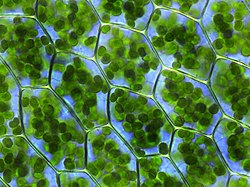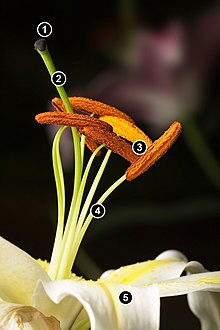Plant
| Plantae Temporal range: Mesoproterozoic–present
| |
|---|---|

| |
| Scientific classification | |
| (unranked): | Archaeplastida |
| Kingdom: | Plantae sensu Copeland, 1956 |
| Divisions | |
| |
| Synonyms | |
| |


Plants are one of six big groups (kingdoms) of living things. They are autotrophic eukaryotes, which means they have complex cells, and make their own food. Usually, they cannot move (not counting growth).
Plants include familiar types such as trees, herbs, bushes, grasses, vines, ferns, mosses, and green algae. The scientific study of plants, known as botany, has identified about 391,000 extant (living) species of plants. [5] Fungi and non-green algae are not classified as plants.
Most plants grow in the ground, with stems in the air and roots below the surface. Some float on water. The root part absorbs water and some nutrients the plant needs to live and grow. These climb the stem and reach the leaves. The evaporation of water from pores in the leaves pulls water through the plant. This is called transpiration.
A plant needs sunlight, carbon dioxide, minerals from the soil and water to make food by photosynthesis. A green substance in plants called chlorophyll traps the energy from the Sun needed to make food. Chlorophyll is mostly found in leaves, inside plastids, which are inside the leaf cells. The leaf can be thought of as a food factory. Leaves of plants vary in shape and size, but they are always the plant organ best suited to capture solar energy. Once the food is made in the leaf, it is transported to the other parts of the plant such as stems and roots.[6][7]
The word "plant" can also mean the action of putting something in the ground. For example, farmers plant seeds in the field.
Types of plants[change | change source]
Land plants (embryophyte)
- Non-vascular plants (bryophytes):
- Liverworts
- Mosses
- Hornworts
- †Horneophytopsida
- Vascular plants (tracheophytes)
- Lycopodiophyta—clubmosses
- Pteridophyta: the ferns
- Pteridopsida: the typical ferns
- Sphenopsida: the horsetails
- Marattiopsida: a divergent group of ferns
- Psilotopsida
- sister-group to all other ferns
- †Rhyniophyta—rhyniophytes
- †Zosterophyllophyta—zosterophylls
- †Trimerophytophyta—trimerophytes
- †Progymnospermophyta
- Seed plants (spermatophytes)
- †Pteridospermatophyta: the seed ferns
- Pinophyta: the conifers
- Cycadophyta: the cycads
- Ginkgophyta: the ginkgos
- Gnetophyta: sister group to the Angiosperms
- Magnoliophyta or Angiosperms (flowering plants)
- †Nematophytes
The plant food factory[change | change source]

At least some plant cells contain photosynthetic organelles (plastids) which enable them to make food for themselves. With sunlight, water, and carbon dioxide, the plastids make sugars, the basic molecules needed by the plant. Free oxygen (O2) is produced as a by-product of photosynthesis.[8]
Later, in the cell cytoplasm, the sugars may be turned into amino acids for proteins, nucleotides for DNA and RNA, and carbohydrates such as starch. This process needs certain minerals: nitrogen, potassium, phosphorus, iron and magnesium.[9]
Plant nutrients[change | change source]
Plant nutrition is the study of the chemical elements that are necessary for plant growth.
Macronutrients:
- N = Nitrogen (Carbohydrates, amino acids & glycolipids)
- P = Phosphorus (ATP and the energy cycle)
- K = Potassium (water regulation, opening and closing of stomata in some plant species)
- Ca = Calcium (transport of other nutrients)
- Mg = Magnesium (major constituent of chlorophyll, activator to various enzymes)
- S = Sulfur (some amino acids)
- Si = Silicon (cell walls)
Micronutrients (trace elements) include:
- Cl = Chlorine (osmosis and ion balance)
- Fe = Iron (photosynthesis ans enzyme co-factor)
- B = Boron (sugar transport and cell division)
- Mn = Manganese (building chloroplasts)
- Na = Sodium (various)
- Zn = Zinc (activator to many enzymes)
- Cu = Copper (photosynthesis)
- Ni= Nickel (an enzyme)
- Mo = Molybdenum (enzyme co-factors)
Roots[change | change source]
The roots of plants perform two main functions. First, they anchor the plant to the ground. Second, they absorb water and various nutrients dissolved in water from the soil. Plants use the water to make food. The water also provides the plant with support. Plants that lack water become very limp and their stems cannot support their leaves. Plants which specialise in desert areas are called xerophytes or phreatophytes, depending on the type of root growth.
Water is transported from the roots to the rest of the plant through special vessels in the plant. When the water reaches the leaves, some of it evaporates into the air. Many plants need the help of fungi to make their roots work properly. This plant/fungi symbiosis is called mycorrhiza. Rhizobia bacteria in root nodules help some plants get nitrogen.[10]
Flowering plant reproduction[change | change source]
Flowers and pollination[change | change source]

Flowers are the reproductive organ only of flowering plants (Angiosperms). The petals of a flower are often brightly colored and scented to attract insects and other pollinators. The stamen is the male part of the plant. It is composed of the filament (a stalk) that holds the anther, which produces the pollen. Pollen is needed for plants to produce seeds. The carpel is the female part of the flower. The top part of the carpel contains the stigma. The style is the neck of the carpel. The ovary is the swollen area at the bottom of the carpel. The ovary produces the seeds. The sepal is a leaf that protects a flower as a bud.
How pollen moves from one flower to another flower is called pollination. This transfer can happen in different ways. Insects such as bees are attracted to bright, scented flowers. When bees go into the flower to gather nectar, the spiky pollen sticks to their back legs. The sticky stigma on another flower catches the pollen when the bee lands or flies nearby it.
Some flowers use the wind to carry pollen. Their dangling stamens produce lots of pollen that is light enough to be carried by the wind. Their flowers are usually small and not highly coloured. The stigmas of these flowers are feathery and hang outside the flower to catch the pollen as it falls.[11]
Seed travelers[change | change source]
A plant produces many spores or seeds. Lower plants such as moss and ferns produce spores. The seed plants are the Gymnosperms and Angiosperms. If all the seeds fell to the ground besides the plant, the area might become overcrowded. There might not be enough water and minerals for all the seeds. Seeds usually have some way to get to new places. Some seeds can be dispersed by the wind or by water. Seeds inside juicy fruits are dispersed after being eaten. Sometimes, seeds stick to animals and are dispersed that way.[12]
Fossils[change | change source]

The question of the earliest plant fossils depends on what is meant by the word "plant".
- If by plants we mean phototrophs using chlorophyll, then cyanobacteria in stromatolites are the first fossils, 3,450 million years ago (mya) in the Archaean eon. The remarkable precision is possible because the fossils were sandwiched between lava flows that could be precisely dated from embedded zircon crystals.[18][19]
- If by plants we include all types of algae, then the earliest known red algae lived 1.6 billion years ago. Fossils of them were recently found in India.[20]
- If by plants we mean green plants, Viridiplantae, then the first fossils are green algae. This is probably the majority position amongst professional botanists. There is convincing evidence for the monophyly of charophyte green algae and embryophytes.[21] There are still two choices:
- Acritarchs (a group of organic-walled microfossils) may be reproductive cysts of green algae. If so, they are present in the Neoproterozoic era, 1000 mya.[22]
- Otherwise, there is a large increase in planktonic algae around 540 mya in the Cambrian period.[22]
- If by plants we mean land plants, the first fossils are in the Silurian.[23]
By the Silurian, fossils of whole plants are preserved, including the lycophyte Baragwanathia. From the Devonian, detailed fossils of rhyniophytes have been found. Early fossils of these ancient plants show the individual cells within the plant tissue. The Devonian period also saw the evolution of the first tree in the fossil record, Wattezia. This fern-like tree had a trunk with fronds, and produced spores.
The coal measures are a major source of Palaeozoic plant fossils, with many groups of plants in existence at this time. The spoil heaps of coal mines are the best places to collect; coal itself is the remains of fossilised plants, though structural detail of the plant fossils is rarely visible in coal. In the Fossil Forest at Victoria Park in Glasgow the stumps of Lepidodendron trees are found in their original growth positions.
Related pages[change | change source]
References[change | change source]
- ↑ Cavalier-Smith, T. (1981). "Eukaryote kingdoms: Seven or nine?". BioSystems. 14 (3–4): 461–481. doi:10.1016/0303-2647(81)90050-2. PMID 7337818.
- ↑ Lewis, L.A.; McCourt, R.M. (2004). "Green algae and the origin of land plants". American Journal of Botany. 91 (10): 1535–1556. doi:10.3732/ajb.91.10.1535. PMID 21652308.
- ↑ Kenrick, Paul; Crane, Peter R. (1997). The origin and early diversification of land plants: A cladistic study. Washington, D. C.: Smithsonian Institution Press. ISBN 1-56098-730-8.
- ↑ "The new higher level classification of eukaryotes with emphasis on the taxonomy of protists" (PDF). Journal of Eukaryote Microbiology. 52 (5): 399–451. 2005. doi:10.1111/j.1550-7408.2005.00053.x. PMID 16248873. S2CID 8060916.
{{cite journal}}: Cite uses deprecated parameter|authors=(help) - ↑ "How many plant species are there in the world? Scientists now have an answer". Mongabay Environmental News. 12 May 2016. Retrieved 13 October 2023.
- ↑ Asimov, Isaac 1968. Photosynthesis. Basic Books, New York, London. ISBN 0-465-05703-9.
- ↑ Intermediate Learn Science, grades 5-6, by Mike Evans and Linda Ellis
- ↑ Smith A.L. 1997. Oxford dictionary of biochemistry and molecular biology. Oxford University Press. p508 ISBN 0-19-854768-4. "Photosynthesis -- the synthesis by organisms of organic chemical compounds, esp. carbohydrates, from carbon dioxide using energy obtained from light rather than the oxidation of chemical compounds".
- ↑ Rabinowitch E. and Govindjee 1969. Photosynthesis. Wiley, London. ISBN 0-471-70424-5
- ↑ Mauseth, James D. 2003. Botany: an introduction to plant biology. Jones & Bartlett, Boston.
- ↑ Pous, Dinora. Science and plants. Blue Planet.
- ↑ Fenner, Michael and Thompson, Ken 2005. The ecology of seeds. Cambridge. ISBN 978-0-521-65368-8
- ↑ T. Cavalier Smith 2007, Evolution and relationships of algae major branches of the tree of life. from: Unravelling the algae, by Brodie & Lewis. CRC Press
- ↑ Ševčíková, Tereza; et al. (2015). "Updating algal evolutionary relationships through plastid genome sequencing". Scientific Reports. 5: 10134. Bibcode:2015NatSR...510134S. doi:10.1038/srep10134. PMC 4603697. PMID 26017773.
- ↑ Theodor Cole & Hartmut Hilger 2013 Bryophyte Phylogeny Archived 2015-11-23 at the Wayback Machine
- ↑ Theodor Cole & Hartmut Hilger 2013 Trachaeophyte Phylogeny
- ↑ Theodor Cole & Hartmut Hilger 2015 Angiosperm Phylogeny, Flowering Plant Systematics. Freie Universität Berlin
- ↑ J. William Schopf 1999. Cradle of Life: the discovery of Earth's earliest fossils. Princeton U. Press (pages 87-89 and figure 3.9) ISBN 0-691-00230-4
- ↑ Knoll, Andrew H. 2004. Life on a young planet: the first three billion years of evolution on Earth. Princeton, N.J. ISBN 0-691-12029-3
- ↑ Briggs, Helen 2017. 'Oldest plants on Earth' discovered. BBC News Science & Environment. [1]
- ↑ Lewis L.A & R.M. McCourt 2004 (2004). "Green algae and the origin of land plants". American Journal of Botany. 91 (10): 1535–1556. doi:10.3732/ajb.91.10.1535. PMID 21652308. Archived from the original on 2007-10-28. Retrieved 2012-12-21.
no
{{cite journal}}: CS1 maint: numeric names: authors list (link) - ↑ 22.0 22.1 Willis K.J. & McElwain J.C. 2002. The evolution of land plants. Oxford University Press, 38. ISBN 0-19-850065-3
- ↑ Wellman, Charles H.; Osterloff, Peter L. & Mohiuddin, Uzma 2003. Fragments of the earliest land plants. Nature 425: 282–285. [2]
